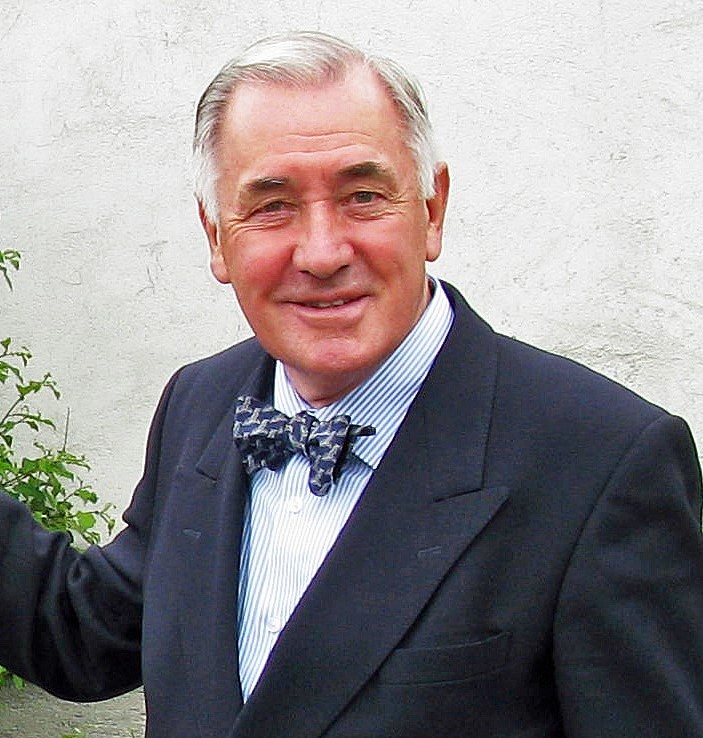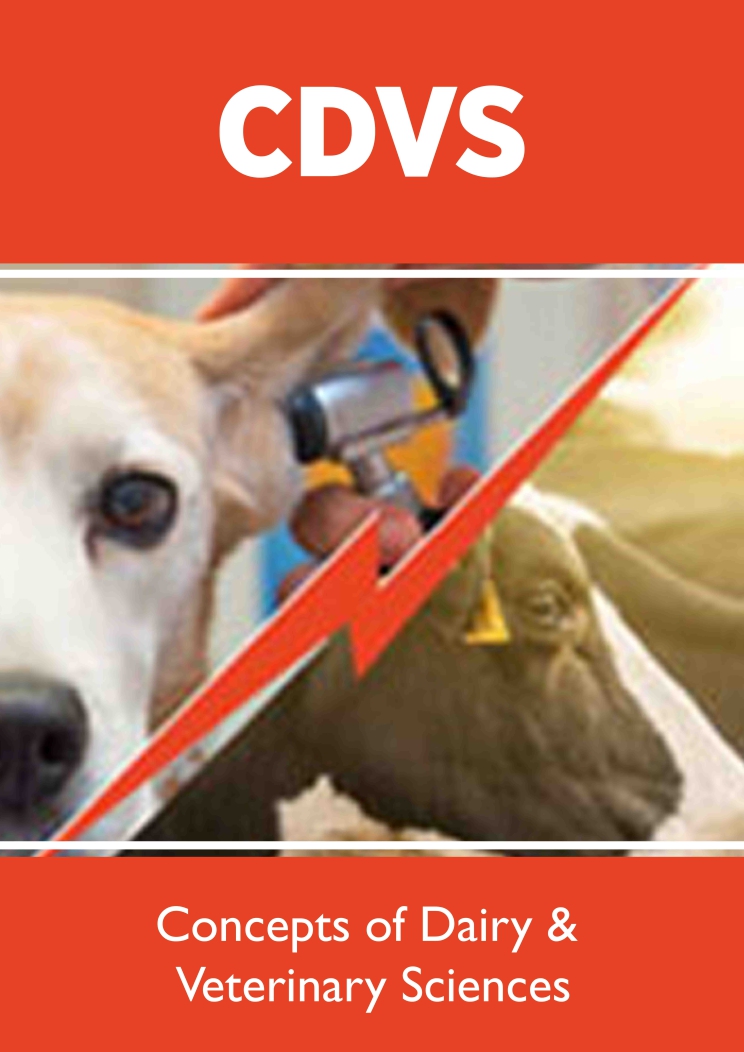
Lupine Publishers Group
Lupine Publishers
Menu
ISSN: 2637-4749
Research Article(ISSN: 2637-4749) 
Health Status and Culling of Postpartum Dairy Cows Vaccinated with Commercial Intranasal Vaccines after Calving Volume 5 - Issue 4
Luís GD Mendonça¹*, Christopher S Schneider¹, Lowell T Midla¹, Todd R Bilby¹, Jeffrey S Stevenson²
- 1Merck Animal Health, Rahway, NJ, USA
- 2Department of Animal Sciences and Industry, College of Agriculture, Kansas State University, USA
Received: June 13, 2024; Published: June 18, 2024
Corresponding author: Luís GD Mendonça, Merck Animal Health, Rahway, NJ, USA
DOI: 10.32474/CDVS.2024.05.000221
Abstract
An experiment was conducted to document incidences of health alerts, pneumonia, mortality, sale, culling, and total health events in dairy cows during the first 60 days in milk (DIM) after vaccination with an intranasal modified live virus (MLV) vaccine on the day of calving compared with unvaccinated-control cows. Nulliparous (n = 1,502) and parous (n = 2,978) Holstein-Jersey females in 1 herd were submitted randomly to either of 3 vaccine treatments, which consisted of administration of either of 3 commercial intranasal vaccines on the day of calving or no vaccination (control; n = 1,105). Treatments were vaccine A (n = 1,080), vaccine B (n = 1,175), or vaccine C (n = 1,120). Females were fitted with a neck-mounted automated activity monitoring tag 2 weeks before calving to monitor daily rumination, which was used to calculate a health index for each cow to produce health alerts. Incidences of pneumonia (3.2 to 3.7%), mortality (1.7 to 2.0%), culling (5.3 to 6.1%), sale (3.9 to 4.3%), health alerts (32.4 to 35.5%), and total health events (44.8 to 48.9%) did not differ (P > 0.30) from those of unvaccinated control cows. Small daily differences in rumination activity (11 to 13 minutes/day) in primiparous cows were detected between unvaccinated controls and vaccinated cows in postpartum weeks 1 and 3. We concluded that, under the given circumstances of this study, vaccinating dairy cows with MLV on the day of calving did not improve postpartum health or reduce mortality and culling during the first 60 DIM.
Keywords: Intranasal vaccines; Culling; Dairy cow; Pneumonia; Rumination
Methodology, Results and Discussion
Postpartum diseases impact the overall efficiency of lactating dairy cows [1]. Vaccination strategies have been explored to prevent or reduce incidence of specific postpartum disorders [2- 4]. Intranasal vaccines for aid in prevention of bovine respiratory disease (BRD) have been recently investigated as a potential strategy to reduce negative postpartum health outcomes in dairy cows [5]. Although BRD is uncommonly the most prevalent disease after calving [6], cows diagnosed with pneumonia are expected to have increased mortality and morbidity. Therefore, minimizing the incidence of BRD after calving on dairy farms is desirable.
Most research studies evaluating efficacy and mechanism of action of administering modified-live virus (MLV) intranasal vaccines were conducted with calves [7-9]. Reports have shown that intranasal vaccines modulate innate and acquired immune responses [7,8] and reduce incidence of BRD at weaning [10]. Nonetheless, a previous study conducted during the transition period of dairy cows has shown that intranasal vaccination with a MLV induced dismal local and systemic immunological responses [11]. Because of the scarcity of reports on the topic, the objectives of this experiment were to compare incidence of postpartum health disorders, BRD (pneumonia), and culling of cows vaccinated or not with intranasal vaccines after calving. We hypothesized that postpartum cows vaccinated with a MLV vaccine would have reduced incidence of postpartum health diseases, pneumonia, and culling than unvaccinated-control cows during the first 60 days in milk (DIM).
Materials and Methods
Cows, facilities, and treatments
Holstein-Jersey crossbred cows on a large commercial dairy farm located in the Southwest were used in this study. Prepartum and postpartum cows were housed in cross-ventilated free stall barns. Cows were fed a total mixed diet calculated to meet nutrient requirements for gestating or lactating dairy cows producing 35 kg of 3.5% milk fat and provided water ad libitum [12]. Postpartum cows were milked twice daily in a 110-stall rotary parlor. Other procedures conformed to guidelines for use of agricultural animals in research [13].
Enrollment period of the experiment was from August through November 2021. Before initiating the experiment, females expected to calve during the enrollment period were assigned randomly to either of 3 vaccine treatments or to serve as nonvaccinated untreated controls in the on-farm management software (Dairy Comp, Valley Ag Software, Tulare, CA). Nulliparous (n = 1,502) and parous (n = 2,978) cows were submitted to the preassigned treatments, which consisted of administering either of 3 commercial intranasal vaccines by 1 hour of after calving or no vaccination (control; n = 1,105). Treatments were vaccine A (Bovilis Nasalgen 3-PMH, Merck Animal Health, DeSoto, KS; n = 1,080), vaccine B (Bovilis Nasalgen 3, Merck Animal Health, DeSoto, KS; n = 1,175), or vaccine C (Inforce-3, Zoetis, Parsippany, NJ; n = 1,120). Single-dose (2-mL) vaccine vials were reconstituted immediately before administration of the respective vaccine. Treatment was administrated in one nostril using a single use canula.
Postpartum Monitoring, Health Status, and Culling
Cows were fitted with a neck-mounted monitoring tag (Sense Hub Dairy Technology, Merck Animal Health, De Soto, KS) 2 weeks before calving to monitor daily rumination and activity. Based on the information collected by the tag, a proprietary machinelearning algorithm was used to calculate a health index for each cow (20 = lowest health score; 100 = highest health score). The daily health index was stored in the monitoring device software and served as a health alert, which was transferred automatically to the on-farm management software. Weekly visits by one member of the research team monitored the experiment. Dairy personnel including an in-house veterinarian conducted a physical exam of postpartum cows after the morning milking when the health index was <70. Physical exams consisted of evaluating appetite, manure consistency, rumen motility, respiratory rate, rectal temperature, and blood ketones using a cow-side test.
Dairy personnel were trained and supervised by the herd veterinarians. Respiratory disease (coded as pneumonia) was defined as rectal temperature ≥103.1 °F (39.5 °C), increased respiratory rate, and auscultation of abnormal lung sounds, such as crackles and wheezes. The occurrence of pneumonia and other postpartum diseases (retained placenta, metritis, lameness, mastitis, digestive issues, diarrhea, ketosis, and displaced abomasum) were recorded in the on-farm management software. Records related to health alerts, pneumonia, other postpartum diseases, and culling (dead or sold) during the first 60 DIM were extracted from the on-farm management software. In addition, information related to stillbirth (born dead or died by 12 hours after parturition), twinning, and gestation length were extracted from the on-farm management software. Daily rumination and health index from calving through 21 DIM were extracted from the monitoring device software.
Temperature-Humidity Index
Relative humidity and temperature were collected from a meteorological station located approximately 15 miles (24 km) from the dairy farm to calculate the temperature-humidity index (THI) using the following equation: T- (0.55- [0.55 × RH/100] × [T- 58]); where T and RH are dry bulb temperature (°F).
Statistical Analyses
Cow was the experimental unit. Descriptive data were averaged by treatment to verify randomness of applied treatments. Because multiple nuisance variables influence health, milk production, and reproductive outcomes of dairy cows, [1,4,6,14-16], each model was adjusted by 3 covariates: (1) percentage of hours with THI ≥ 72 during the last 14 days of gestation; (2) number of days in the close-up pen; and (3) any health event that occurred on the day of parturition (twinning, calf born dead, mastitis, retained placenta, pneumonia, lameness, death, digestive, ketosis, diarrhea, displaced abomasum, or other illness). Retrospective power tests were conducted to determine if adequate sample size per treatment was applied in the study. From the mean response in the nonvaccinated controls for each of the reported binomial results, a minimum of 900 to 1,200 cows per treatment were required to detect a 2-percentage point difference (α = 0.05 and β= 0.70 to 0.80) between controls and each treatment for the percentage incidences of pneumonia, mortality, and sold. To detect a 5-percentage difference (α = 0.05 and β = 0.75 to 0.80) in health alerts and total disease events from the control response, a minimum of 1,100 to 1,200 cows per treatment were required. To detect a 10-minute difference (α= 0.05 and β = 0.80) in daily rumination time per treatment, 394 cows were required per treatment. Dichotomous outcomes were analyzed by logistic regression (procedure GLIMMIX) in SAS version 9.4, SAS Institute Inc., Cary, NC. Options used in the model statement included LINK = LOGIT, DIST = BINOMIAL, and the least squares means option of ILINK and DIFF. Final models included the fixed effects of treatment (n = 4), parity (primiparous vs. multiparous), their interaction, and the 3 covariates defined previously.
All non-dichotomous variables (e.g., rumination time) were tested for normality by using the UNIVARIATE procedure and subsequently analyzed using mixed models (procedure MIXED) in SAS. The final model for non-dichotomous outcomes applied the same model as described previously for the dichotomous outcomes. Rumination time was averaged for each 2-hour block per day and then averaged for each of the first 3 weeks after calving. The model was subjected to repeat measure split-plot analysis with the fixed effect of treatment (n = 4), week (repeat measure), their interaction, cow as the random subject, all other two-way interactions, and the 3- way interaction of week, parity, and treatment in addition to the 3 covariates described previously. Treatment effects were tested by the split-plot error (cow within treatment) and all other effects were tested by the whole plot random error term. The final model included an unstructured covariance structure because it produced the smallest Akaike’s information criteria compared with six other covariance structures tested.
A priori contrasts were designed to compare each vaccine treatment with the untreated control. In all cases, statistical significance of effects was set as P < 0.05, with tendencies as 0.05 < P < 0.10.
Results
Descriptive data of cows enrolled in the study are summarized by treatment (Table 1). Only DIM in the close-up pen differed (P = 0.01) among treatments. Days in the close-up pen for cows in vaccine C tended (P = 0.06) to differ from control. All traits in Table 1 averaged across treatments differed (P < 0.01) between primiparous and multiparous cows except for stillbirths (2.3 vs. 1.6%, P = 0.11), respectively. Multiparous compared with primiparous cows had longer gestations (278.1 ± 0.1 vs. 274.1 ± 0.1 days), fewer days in the close-up pen (18.1 ± 0.2 vs. 22.1 ± 0.2), more percentage of hours when THI was ≥ 72 during 14 days before calving (36.6 ± 0.4 vs. 34.0 ± 0.6), more health events on the day of parturition (4.0 vs. 2.5%), more twins (2.2 vs. 0.6%), more projected mature equivalent 305-d milk (13,937 ± 62 vs. 11,139 ± 92 kg), and fewer dairy heifers born (18.1 vs.79.7%), respectively. The large difference in the percentage of dairy heifers born between parity groups occurred because replacement heifers (primiparous cows enrolled in study) were inseminated with sexed dairy semen, whereas parous cows were inseminated with beef or dairy conventional semen.
Incidence of Disease
Occurrence of disease and culling events during the first 60 DIM are summarized in (Table 2). In no case were significant interactions detected between treatment and parity for percentages of disease occurrence. Vaccination did not reduce (P = 0.72) incidence of pneumonia during the first 60 DIM compared with control. In addition, mortality and percentage of cows sold during the first 60 DIM did not differ (P > 0.47) among treatments (Table 2). Percentage of cows culled (dead or sold) by 60 DIM also did not differ (P = 0.53) among treatments (Table 2). Days in milk at culling ranged from 17.8 to 22.9 ± 2.0 in vaccine-treated cows but did not differ (P = 0.35) from the controls (21.0 ± 1.8 days).
The percentage of health alerts triggered by the automated activity tags did not differ (P = 0.41) among treatments and ranged from 32.4 to 35.5% in the vaccine-treated cows compared with 35.5% in controls (Table 2). Mean time of first health alerts ranged from 6.6 to 7.2 ± 0.4 DIM. Days in milk at health alerts were less (P < 0.001) in primiparous than in multiparous cows (6.0 ± 0.3 vs. 7.7 ± 0.2). The proportion of cows remaining in the herd during the first 60 DIM that were diagnosed with at least one disease event ranged from averages of 44.8 to 48.9% in vaccine-treated cows, which did not differ (P = 0.30) from the mean of 47.9% in controls (Table 2). Primiparous cows had more (P < 0.001) total health events than multiparous cows (50.6 vs. 43.9%), respectively.
Rumination Activity
Because of an interaction (P = 0.04) of treatment, parity, and week, daily rumination activity was summarized by parity for each of the treatments during the first 3 weeks after calving (Figure 1). The main effects of week (P < 0.001) and parity (P < 0.001) and its interaction (P < 0.001) also were detected. The only trends for differences between treatments in ruminal activity occurred in primiparous cows during weeks 1 and 3. Primiparous cows treated with vaccine C tended (P = 0.06) to ruminate longer (13 ± 5 minutes/day) than controls during week 1 and cows treated with vaccine A tended (P = 0.07) to ruminate longer (11 ± 4 minutes/ day) than controls during week 3.
Otherwise, the greatest changes in rumination activity were associated with parity and week (Figure 1). During week 1 multiparous cows ruminated longer (P < 0.001) than primiparous cows (382 ± 2 vs. 318 ± 2 minutes/day). Primiparous cows had a nearly two-fold (P < 0.001) increase in rumination from weeks 1 to 2 compared with multiparous cows (33.1 vs. 17.7%), respectively, whereas percentage increases (P < 0.01) in rumination activity from week 2 to 3 were small between primiparous and multiparous cows (4.7 vs. 3.6%), respectively.
Figure 1: Daily rumination time (least squares mean ± SEM) during the first 3 weeks after calving in primiparous (top panel) and multiparous cows (bottom panel) treated with Vaccine A (314 primiparous and 648 multiparous cows), Vaccine B (308 primiparous and 700 multiparous cows), Vaccine C (326 primiparous and 648 multiparous cows) or were untreated controls (326 primiparous and 625 multiparous cows). Although overall means were greater (P < 0.001) in multiparous than primiparous cows and within parity, mean rumination time during week 1 was less (P < 0.001) than during weeks 2 or 3, a 3-way interaction of treatment, parity, and week was detected (P = 0.04).

Covariate Adjustments
The importance of including covariates to control nuisance variables was evident. One or 2 covariates used to adjust all outcomes accounted for significant (P < 0.01) variation in incidence and DIM at diagnosis of pneumonia and proportions of cows with death, sold, culling health alerts, and total health events. For every outcome except for incidence of pneumonia, the covariate defining any health event diagnosed on the day of parturition (twinning, calf born dead, mastitis, retained placenta, pneumonia, lameness, death, digestive, ketosis, diarrhea, displaced abomasum, or other illness) was significant. In addition, the THI covariate also was significant for pneumonia, percentages of cows sold and culled, the proportion of health alerts, and rumination activity during the first 60 DIM. Days in the close-up pen tended (P = 0.07) to account for a significant proportion of the variation in postpartum rumination activity.
Discussion
Bovine respiratory disease has a complex pathophysiology involving stress-induced immunosuppression, infection with one or more viruses, and culminates with bronchopneumonia [17]. Timing of BRD vaccination is critical. Sufficient time is required for the act of vaccination to result in immunization against BRD causative agents, and without immunization before pathogen challenge, it is inadvisable to expect positive health outcomes [17]. In an earlier study, cows vaccinated with vaccine C on the day of calving had the smallest death loss during the first 2 months of lactation compared with nonvaccinated controls, cows vaccinated between 2 and 3 weeks before calving, or vaccinations administered at prepartum and postpartum times [5].
Conversely, in the current study, no differences were observed between vaccinated and nonvaccinated controls. Differences in study design should be considered while interpreting the research studies. The previous report kept vaccinated cows in a separate pen from nonvaccinated controls [5]. Unfortunately, the previous study failed to report whether multiple experimental pens were used in the research, thereby lacking a crucial aspect of experimental design necessary for a comprehensive understanding of the study’s findings and potential confounding factors. In the current study, cow was the experimental unit and treatment groups were not housed separately after vaccination. Therefore, caution is warranted when comparing findings between studies.
Our objective was to compare incidence of postpartum health disorders, mortality, and culling of cows vaccinated or not with intranasal vaccines after calving. We rejected our hypothesis that postpartum cows vaccinated with a MLV vaccine would have reduced incidence of postpartum health diseases and culling compared with nonvaccinated control cows during the first 60 DIM. Perhaps older cows (66.5% of the enrolled cows were multiparous) already had antibodies for the antigens to which they were exposed upon vaccination. Disease pressure for the specific antigens may not have been great enough in the test herd, so we were unable to detect any differences. Incidence of BRD was likely small in this herd and that may have contributed to the lack of differences between vaccinated cows and controls. In addition, it is possible that vaccinating cows on the day of calving may not elicit a robust immune response because of periparturient immunosuppression. Physiological and metabolic changes that occur during the periparturient period affect immune response, which could have contributed to the lack of differences between treatments. Further research is needed to investigate the ideal timing to vaccinate cows intranasally during the transition period.
As cited in the results, adjusting for any health event that occurred on the day of calving when vaccinations were administered and controlling for the difference in THI during the last 2 weeks of gestation accounted for significant proportions of the variance in outcomes. These nuisance variables are often ignored in most studies, so the variance of the unaccounted-for nuisance variables becomes part of the error term that is used in the F tests of the analyses of variance. In the present study, removing the covariate variance from the error-term variance produced a greater chance of detecting differences among treatments, which we were unable to detect. This point is most relevant because it is well known that many postpartum health issues are largely correlated and most periparturient disorders occur as a complex rather than a single abnormality so that cows with 1 disorder are at increased risk for other disorders, including metabolic disease [18, 19].
Another reason for no detected differences among treatments could be credited to the health alerts triggered by the activity tags. When a health index < 70 (range of 20 to 100) was recorded, dairy personnel conducted a physical exam of those cows after the morning milking. Physical exams consisted of evaluating appetite, manure consistency, rumen motility, respiratory rate, rectal temperature, and blood ketone concentrations using a cow-side test. It is possible that early diagnosis triggered by the activity tags and subsequent treatment of cows led to fewer postpartum health issues. Although no differences among treatments were detected for total health events and health alerts, health alerts provided by the automated activity tags are an objective way to determine health status and identify sick cows. Anecdotally, the experience of the authors with a history of using two different automated activity monitors that provide health alerts indicates that health alerts trigger potential health issues sooner than acute decreases in daily milk yield. Activity tags identify cows which are not eating, ruminating, have excessive periods of little or no activity, or increased recumbency or lying time. Each or all of which is often associated with illness.
Management activities and facilities can either limit or facilitate vital cow activities such as eating, drinking, lying, resting, ruminating, socializing with pen mates, and standing behavior associated with estrus [20]. These essential activities make up a daily “time budget” for a productive dairy cow housed in a free stall environment [20]: approximately 3 to 5 hours eating, 12 to 14 hours lying/resting, 2 to 3 hours of social interactions, 7 to 10 hours ruminating, 30 minutes drinking, and 2.5 to 3.5 hours outside the home pen (i.e., milking, travel time). Rumination time detected in the present study was approximately 5 to 6.5 hours/day during the first postpartum week but increased to approximately 7 to 7.5 hours/day during weeks 2 and 3 and was consistently greater in multiparous than primiparous cows as reported earlier using a different activity tag [15].
Dairy cows classified as diseased when any case of metritis, digestive disorders, ketosis, hypocalcemia, calving problems, mastitis, or lameness occurred during the first 60 DIM had similar prepartum rumination times as healthy cows, but rumination was greater in healthy than diseased cows after calving [15]. In that study, rumination in healthy cows increased rapidly to a peak on postpartum days 8 to 9 and leveled off, whereas the peak in rumination in diseased cows was delayed to day 15 before leveling off. Consistent with the previous study [15], primiparous cows in the present study ruminated fewer minutes per day than older cows. Increase in rumination, however, was nearly two-fold greater from week 1 to 2 in primiparous than multiparous cows but showed similar increases in rumination from week 2 to 3. Although proprietary algorithms of various automated activity monitors used to define health alerts are unknown, they likely include a combination of such daily times of eating, activity, resting, lying, rumination, and ear skin temperatures to predict health alerts. Most research studies evaluating efficacy and mechanism of action of administering MLV intranasal vaccines were conducted with calves [7-9].
Reports have shown that intranasal vaccines modulated innate and acquired immune responses [7,8], and reduced incidence of BRD at weaning [10]. Previous dogma based on antibody titers supposed a lack of vaccine efficacy in the face of acquired maternal antibodies in young calves; however, subsequent research has demonstrated efficacy of MLV vaccination during this time [21]. Specifically, cellmediated immunity can be acquired from MLV vaccination in young calves with significant concentration of maternal antibodies present from colostrum [22]. Because of management practices of the commercial farm used in the study, vaccinated and nonvaccinated control cows were commingled in the fresh pen after treatments were conducted on the day of calving. It is possible that some viral shedding occurred, potentially immunizing some control cows. This study provides information on whether vaccinating a group of cows in one dairy is expected to improve postpartum health. Findings are still relevant to the industry and these vaccines are safe and caused no negative outcomes in vaccinated cows.
The present report is unique with a large number of cows in which technology was used to determine health status of cows after vaccine treatments. Little information is found in the literature about the application of MLV vaccines in adult dairy cows. Previous reports were small [11], some experiments only included parous cows, [5] or included but one MLV vaccine. We concluded that, under the given circumstances of this study, vaccinating dairy cows with MLV on the day of calving did not improve postpartum health or reduce mortality and culling during the first 60 DIM. Furthermore, the use of technology to detect objectively the health status of cows shows promise for identifying cows having health issues. Use of this technology is most relevant because parturition is one of the most critical parts of the reproductive life cycle and is a period of significant death loss as well as potentially severe debilitating injury and disease to both cow and neonate [19].
References
- Chebel RC, Mendonça LGD, Baruselli PS (2018) Association between body condition score change during the dry period and postpartum health and performance. J Dairy Sci 101(5): 4595-4614.
- Freick M, Kunze A, Passarge O, Weber J, Geidel S, et al., (2017) Metritis vaccination in Holstein dairy heifers using a herd-specific multivalent vaccine-Effects on uterine health and fertility in first lactation. Anim Reprod Sci 184: 160-171.
- Dosogne H, Vangroenweghe F, Burvenich C (2002) Potential mechanism of action of J5 vaccine in protection against severe bovine coliform mastitis. Vet Res 33(1): 1-12.
- Tomazi T, Gonçalves JL, Barreiro JR, Arcari MA, dos Santos MV, et al., (2015) Bovine subclinical intramammary infection caused by coagulase-negative staphylococci increases somatic cell count but has no effect on milk yield or composition. J Dairy Sci 98(5): 3071-8.
- Cortese VS, Pinedo PJ, Manriquez D, Velasquez-Munoz A, Solano G, et al., (2020) Effect of periparturient intranasal vaccination on post parturient health parameters in Holstein cows. Concepts Dairy Vet Sci 3(4): 318-27.
- Pinedo P, Santos JEP, Chebel RC, Galvão KN, Schuenemann GM, et al., (2020) Early-lactation diseases and fertility in 2 seasons of calving across US dairy herds. J Dairy Sci 103(11): 10560-10576.
- Hill KL, Hunsaker BD, Townsend HG, van Drunen Littel-van den Hurk S, Griebel PJ, et al., (2012) Mucosal immune response in newborn Holstein calves that had maternally derived antibodies and were vaccinated with an intranasal multivalent modified-live virus vaccine. J Am Vet Med Assoc 240(10): 1231-40.
- Midla LT, Hill KL, Van Engen NK, Edmonds M, Renter DG, et al., (2021) Innate and acquired immune responses of colostrum-fed neonatal Holstein calves following intranasal vaccination with two commercially available modified-live virus vaccines. J Am Vet Med Assoc 258(10): 1119-1129.
- Ellis JA, Gow SP, Mahan S, Leyh R (2013) Duration of immunity to experimental infection with bovine respiratory syncytial virus following intranasal vaccination of young passively immune calves. J Am Vet Med Assoc 243(11): 1602-8.
- Sandelin A, Härtel H, Seppä-Lassila L, Kaartinen L, Rautala H, et al., (2020) Field trial to evaluate the effect of an intranasal respiratory vaccine protocol on bovine respiratory disease incidence and growth in a commercial calf rearing unit. BMC Vet Res 16(1): 73.
- Cortese VS, Woolums A, Hurley DJ, Berghaus R, Bernard JK, et al., (2017) Comparison of interferon and bovine herpesvirus-1-specific IgA levels in nasal secretions of dairy cattle administered an intranasal modified live viral vaccine prior to calving or on the day of calving. Vet Immunol Immunopathol 187: 35-41.
- (2001) National Research Council (NRC). Nutrient Requirements of Dairy Cattle. 7th rev ed, Natl Acad Sci, Washington, DC.
- (2010) Guide for the Care and Use of Agricultural Animals in Research and Teaching. 3rd ed. Federation of Animal Science Societies (FASS), Champaign, IL.
- Scanavez ALA, Voelz BE, Moraes JGN, Green JA, Mendonça LGD, et al., (2019) Physiological, health, lactation, and reproductive traits of cooled dairy cows classified as having high or low core body temperature during the dry period1. J Anim Sci 97(12): 4792-4802.
- Stevenson JS, Banuelos S, Mendonça LGD (2020) Transition dairy cow health is associated with first postpartum ovulation risk, metabolic status, milk production, rumination, and physical activity. J Dairy Sci 103(10): 9573-9586.
- Carvalho MR, Peñagaricano F, Santos JEP, DeVries TJ, McBride BW, et al., (2019) Long-term effects of postpartum clinical disease on milk production, reproduction, and culling of dairy cows. J Dairy Sci 102(12): 11701-11717.
- Richeson JR, Falkner (2020) Bovine Respiratory Disease Vaccination: What Is the Effect of Timing? Vet Clin North Am Food Anim Pract 36(2): 473-485.
- Oltenacu PA, Britt JH, Braun RK, Mellenberger RW (1984) Effect of health status on culling and reproductive performance of Holstein cows. J Dairy Sci 67(8): 1783-92.
- Stevenson JS, Call EP (1984) Reproductive disorders in the periparturient dairy cow. J Dairy Sci 1988 71(9): 2572-83.
- Grant RJ, Albright JL (1995) Feeding behavior and management factors during the transition period in dairy cattle. J Anim Sci 73(9): 2791-803.
- Windeyer MC, Gamsjäger L (2019) Vaccinating Calves in the Face of Maternal Antibodies: Challenges and Opportunities. Vet Clin North Am Food Anim Pract 35(3): 557-573.
- Platt R, Widel PW, Kesl LD, Roth JA (2009) Comparison of humoral and cellular immune responses to a pentavalent modified live virus vaccine in three age groups of calves with maternal antibodies, before and after BVDV type 2 challenge. Vaccine 27(33):4 508-19.

Top Editors
-

Mark E Smith
Bio chemistry
University of Texas Medical Branch, USA -

Lawrence A Presley
Department of Criminal Justice
Liberty University, USA -

Thomas W Miller
Department of Psychiatry
University of Kentucky, USA -

Gjumrakch Aliev
Department of Medicine
Gally International Biomedical Research & Consulting LLC, USA -

Christopher Bryant
Department of Urbanisation and Agricultural
Montreal university, USA -

Robert William Frare
Oral & Maxillofacial Pathology
New York University, USA -

Rudolph Modesto Navari
Gastroenterology and Hepatology
University of Alabama, UK -

Andrew Hague
Department of Medicine
Universities of Bradford, UK -

George Gregory Buttigieg
Maltese College of Obstetrics and Gynaecology, Europe -

Chen-Hsiung Yeh
Oncology
Circulogene Theranostics, England -
.png)
Emilio Bucio-Carrillo
Radiation Chemistry
National University of Mexico, USA -
.jpg)
Casey J Grenier
Analytical Chemistry
Wentworth Institute of Technology, USA -
Hany Atalah
Minimally Invasive Surgery
Mercer University school of Medicine, USA -

Abu-Hussein Muhamad
Pediatric Dentistry
University of Athens , Greece

The annual scholar awards from Lupine Publishers honor a selected number Read More...






